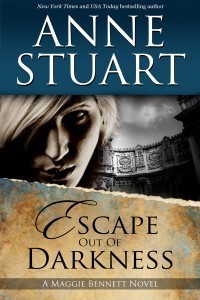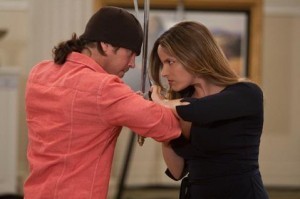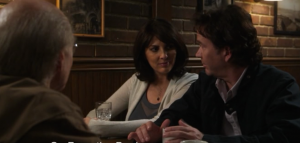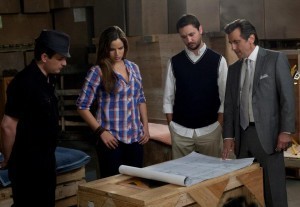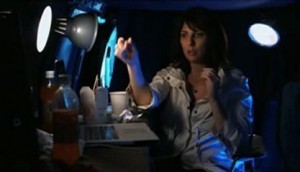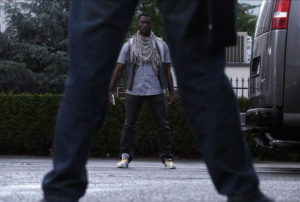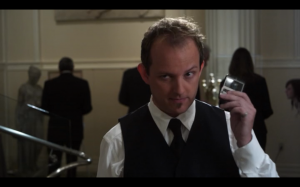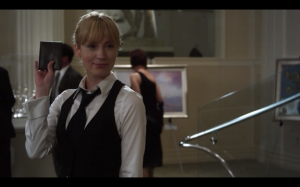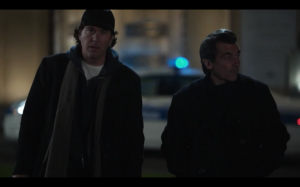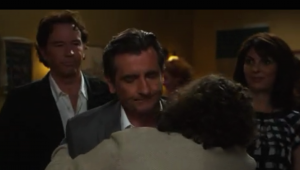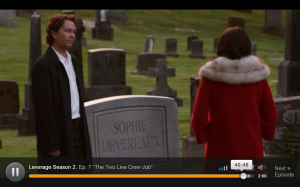Jennifer Crusie's Blog, page 272
March 25, 2014
Questionable: Balancing Drafting and Rewriting
Micki asked:
How do you move from writing relatively polished scenes to brand new scenes? I’m finding my clumsiness sort of disconcerting, even though I intellectually realize that I had the same kind of problems when I was writing the earlier drafts of the polished scene.
This is one of the reasons you shouldn’t polish scenes until you have a full first draft (or the majority of a first draft) done. It’s almost impossible not to rewrite as you go, but a polished scene is one that is perfect, or so close to perfect that you never want to change it. If it’s your last draft, that’s good. If it’s your first through forty drafts, it’s bad. A polished scene is so shiny, it becomes impervious to change. The other scenes still in draft form then have to conform to the polished one because you don’t want to damage the shiny. And that almost always knocks things completely out of whack; you want the entire story staying fluid until the very last draft.
Another reason is that a polished scene is often a dead scene: there’s no excitement in writing it any more. A new scene is still living and breathing. Yes, it’s lousy, but that’s okay, you’re going to rewrite it; the important thing is that it’s all new, it can go anywhere as long as it’s not tied to some damn polished rock, so it’s giving you the fun of writing something new all over again. New scenes rekindle passion that rewriting undercuts. That’s why I think you never stop writing new scenes to polish stuff you’ve already written. Make yourself write ten new pages of rough draft (or whatever number works for you) a week (or whatever span of time works for you). You need to keep generating story until the first draft is done. Then go back and look at the story as a whole, and that’ll tell you what to polish.
As somebody who has cut beautifully rewritten scenes, I can tell you that polishing before the first draft is done is a waste of time and stifler of creativity. The only thing worse than cutting a scene you’ve slaved over is not cutting it if it doesn’t work in the book. My best advice for scenes that are polished brightly before the first draft is done: delete them. But since nobody wants to do that, bury them someplace deep in your hard drive and generate that full first draft, reveling in the excitement of the new scenes and reminding yourself that first drafts are supposed to suck. Then when it’s done, cut and rewrite until the whole thing is shiny.
Polish the story as a whole, not its parts.
Standard Disclaimer: There are many roads to Oz. While this is my opinion on this writing topic, it is by no means a rule, a requirement, or The Only Way To Do This. Your story is your story, and you can write it any way you please.

March 24, 2014
Anne Stuart: 40 Years of Experience
I should probably have titled this “Anne Stuart: 40 Years of Experience With Writing and Publishing,” but frankly, she’s just got a lot of experience about stuff in general. Over on her Drama Queen Blog, she’s talking about her publishing career, a post every day, and it’s great stuff. If you want to read anecdotes about building a career as a goddess in publishing, you should go there. Also she offers something different every day, contests, 99 cent books, free books, a Kindle, but you have to be there on the day to know about it. (Today is a freebie: Escape Out of Darkness.) So really, you should go read the Drama Queen every day.

Subsequently on Leverage, Season Two
Season Two of Leverage is interesting. Having established the team in Season One, the writers test the community in Two: Nate’s sober and mean, Sophie leaves two-thirds of the way through to find herself, and then Nate starts drinking again and comes undone, leaving the kids to band together to survive. Sophie’s departure was not a production decision: Gina Bellman was gone for six episodes on pregnancy leave, so they did the smartest thing possible and kept her in touch with team through phone calls and Skype, but her loss is felt keenly. It’s an oddly disjointed season, which made analyzing it for community growth a challenge.
Still, I think that testing is important for the growth of any community, just as it is in any relationship. “The Bottle Job” is the episode in which Nate starts drinking again, which means it’s a good one to look at for a community that’s breaking from within, so I’m switching to that for Sunday. I’m also dropping and adding shows to the schedule to give better topics on aspects of community. Apologies for the changes.
The New Schedule:
Mar 30 “The Bottle Job” by Christine Boylan (2-14) External/Internal Conflict
Apr 6 “The Three Strikes Job” and “The Maltese Falcon Job” by John Rogers (2-14/15)
Apr 13 “The Inside Job” by Geoffrey Thorne (3-3) Integrating Single Character Back Story
Apr 20 “The Rashomen Job” by John Rogers (3-11) POV
Apr 27 “The Lonely Hearts Job” Kerry Glover (4-15) Integrating Romance
May 4 “The Radio Job/The Last Dam Job” Chris Downey & Paul Guyot; John Rogers(4-17/18) Beginnings, Endings, and Call Backs
May 11 “The Broken Wing Job” by M. Scott Veach & Rebecca Kirsch (5-8) Completed Character Arc
May 18 “The Rundown Job” by Chris Downey & Josh Schaer (5-9) and “The Frame Up Job” by Geoffrey Thorne & Jeremy Bernstein (5-10) Foreshadowing
May 25 “The Long Good-bye Job” Chris Downey & John Rogers (5-15) Endings

March 23, 2014
Leverage Sunday: The Two Live Crew Job: Foils and Dopplegangers
Before we get to Leverage, let’s talk about foils and doppelgängers.
A foil, in literary terms, is a character who stands in comparison to another character, and by contrast, illuminates the second character. It takes its name from the jeweler’s practice of backing their diamond cases with foil to make the gems shine brighter, but in fiction it’s done to deepen the reader or viewer’s understanding of character. Take Macbeth and Banquo, for example (because their my favorite example).
At the start of the play, Macbeth and Banquo are much the same character, brave generals who have just won a victory for a king they’re loyal to. Enter the witches with prophecies for both; Banquo rejects his prophecy to stay loyal to his king, Macbeth goes home and tells the wife about his and it’s all downhill from there. Midway through the third act of this five-act play, after Macbeth has murdered his way to the crown, he invites Banquo to share in his success, promising him titles and riches, and Banquo tells him he doesn’t want anything that was not gotten honestly. So Macbeth has him killed. This might seem an over-reaction to an imprudent lack of tact, but not when you take into consideration that Banquo has become Macbeth’s foil. Macbeth can justify his actions to himself only as long as he’s not looking at the man he used to be, the man he can never be again. Macbeth knows he’s going to hell for his crimes, and it doesn’t help in the slightest looking at Banquo, clearly being fitted for angel’s wings. The only way Macbeth can keep from going crazy with guilt and regret is to kill Banquo. That’s the power of the foil.
A doppelgänger, on the other hand, is less literary and more folklore and legend-based. A doppelgänger (“look-alike”) is a character’s shadow-self, usually evil, which is why antagonists are often doppelgängers. For example, at the beginning of Raiders of the Lost Ark, Indiana Jones is stealing a religious icon from a South American tribe, ignoring the fact that he’s damaging the spiritual life of others; his Nazi doppelgänger Belloq immediately steals it from him. Jones is Good and Belloq is Bad, but as the opening makes clear, they’re the same culturally insensitive looters, spiritually bankrupt doppelgängers.
The difference, then, between the foil and the doppelgänger is that the foil provides a contrast (the foil’s presence in the narrative actively does something for the story), but the doppelgänger is just a psychological double, a character attribute. Therefore, the key to making the doppelgänger antagonist work in the narrative is to use him or her as a foil. That is, the plot of a story begins on the Day That Is Different for the protagonist, the day that he begins to change and his character begins to arc because events are blowing up in his face. But while the protagonist begins to change on that day, the doppelgänger antagonist does not, which means that at the end of the story when they meet at that final obligatory climactic scene, the reader can look at the protagonist and the antagonist and clearly understand how much the protagonist has changed because who he was to begin with is standing right there beside him. So Indiana Jones lets Belloq take the ark to save the woman they both love, and then tells her, “Don’t look,” when Belloq opens the ark because he knows now that the spiritual dimension of life is unknowable and powerful beyond words and should be left to the people who believe in it and understand it. Because of that, Jones gets both the girl and the ark; if that scene had been played at the beginning of the story, he’d be the same gruesome puddle of bleah that Belloq ends up as.
Which brings us to “The Two Live Crew Job,” one of the best use of doppelgängers as foils I’ve ever seen on the screen. The premise is both simple and elegant. The Leverage team comes up against the team they used to be: a hitter, a hacker, and a thief, loners brought together by a mastermind for one job. If you cast your mind back to the pilot, you’ll remember that Nate was the mastermind who worked with a team of loners for one job only. Nate and Stark are doppelgängers, but that’s only important in the story because Stark is such an excellent foil for Nate, just as Stark’s team is an excellent foil for Nate’s community.
Inciting Event: “Let’s Go Steal A Painting”
The episode starts out the same as always, good people harmed by bad men with money, in this case a software developer without a conscience. The team sets out to steal a painting from him, only to find another team, the Evil Team, has been there before them. As our team regroups from the setback, they’re hit with another disaster, Sophie is trapped in her apartment, holding a bomb with a motion sensor trigger. The team first refuses to leave and finally goes only when Sophie tells them to get out; Nate still refuses to leave and even when Sophie makes him, stays outside, his shadow plain on the open door, as Sophie drops the bomb and runs. Lost in all the tension around the bomb is one important fact: The team had a member who was about to die, and they stuck by her; they’ve come a long way since the pilot episode.
The next scene is Sophie’s funeral, or rather the funeral of Katherine Clive, her alias in Boston. Eliot, Parker, and Hardison each say something that reflects how the team has become family–Hardison’s “Sometimes friends are the only family you have” is especially poignant–even though Eliot and Hardison know she’s not dead (Parker’s a little unclear on that). Then a stranger comes up to Nate and expresses his sympathy, and Sophie, not the kind of person to miss her own funeral, recognizes him as Marcus Stark, a partner-in-crime from her past. Back at the apartment, Hardison says, “You saw another team before us?” but Eliot gets to the point as Nate goes into overdrive in his determination to defeat Stark: “What bugs you more, is it the fact that he was with Sophie first or that he outsmarted you?”
Then Sophie fills in the important detail: Stark puts together a temporary team when he works. That means that although the scene immediately goes into a crosscut with Nate and Stark as doppelgängers talking to their teams in the same way, Stark’s team will always be a foil for Nate’s team because Stark’s team is temporary and Nate’s team is family. The fact that Nate and Stark are doppelgängers makes the scene fun, but the fact that the teams are foils makes the scene important.
Change of Plans: “He’s Going To Come Up With a Bigger, Riskier Plan”
As they go into action, Sophie’s stuck in the van with Hardison, who tells her at one point, “We trust Nate to make sure the plan works; we trust you to make sure we’re okay.” It’s a nice moment, but it’s also a foil moment: Stark’s crew has a mastermind/grifter, a hacker, a hitter, and a thief, but it doesn’t have a Sophie, it’s short one crucial member, the one who makes sure that everyone’s okay, because Stark doesn’t care that everyone’s okay.
Meanwhile, Hardison, Eliot, and Parker all meet their opposite numbers and are either defeated or retire from a stalemate: Parker meets Apollo (Apollo Robbins in his first acting role; he’s the pickpocket who trained Beth Reisgraf to do lifts, and all of the lifts in the episode are real including that flipping-the-tray bit); Eliot meets Mikel Dayna (played by Noa Tishby, who really was once in the Israeli army; their imaginary battles are played out as B kung fu movies complete with scratched film), and Hardison meets Chaos (played by Wil Wheaton who makes a great jerk as the two of them do a Nerd High Noon).
Reeling from their checkmate by the other team, Our Guys go back to the apartment to regroup as Nate starts to lose it. When Eliot asks Sophie how things are going to play out, she says, “He’s been challenged, his ego’s been hurt, he’s going to come up with a bigger, riskier plan,” and Eliot has to ask for clarification: Is she talked about Nate or Stark? She says Nate, but it’s clear that they’re both reacting in the same way, as the story goes to cross cuts again, switching between Nate and Stark as they talk to their teams in the same way, move in the same way, fueled by the same angry intensity, two men who are the same man: our doppelgänger protagonist and antagonist. (Every time I see this scene, I’m amazed all over again at how cleanly, clearly, beautifully, they establish that while making it fun to watch.) The last line–”Let go steal/ourselves a masterpiece” is split perfectly between the two and kicks off the third act.
Point of No Return: Let’s Go Steal Ourselves a Masterpiece
That third act is just a good time as the opposite numbers meet again and engage (Parker and Apollo talk birds, Eliot and Mikel beat each other up as foreplay), especially when Nate’s drunk act is interrupted by Stark, dressed like Nate, introducing himself as Nate. That makes Stark the new Evil Nate (sorry, Sterling), the doppelgänger made flesh as he steals Nate’s life. “You all out of tricks, Nate?” he says, gloating as a police car pulls up.
Crisis: “You All Out of Tricks, Nate?”
But it’s all part of Nate’s plan as Hardison goes to backup power, Parker arrests Apollo, Eliot kisses Mikel and snaps handcuffs on her, and Sophie gets out of the cop car. Nate wins, but he has a big advantage, a coordinated team, a community that knows each other well and can play off each other, while all Stark has are employees, and one of those is trying to kill him. Because his team is a community, Nate owns Stark at the end of the third act, having taken two members of his team (as Parker plays pick-the-lock with Apollo and Eliot and Mikel compare scars and foreplay with handcuffs) and sent the third on the run.
Climax:
Nate offers Stark a deal: his people in trade for the first painting he stole, the one they need for their clients. Stark’s reply is perfect foil-speak: “Do I look like Moses? They’re not my people.” What he will trade for is the Van Gogh. Nate’s coup de grace is forcing Stark to become Nate Ford the Good Guy as he hands back the painting, something that clearly pains Stark. Then they send him off with one of his own fakes, and use the rest of the fakes and the real painting to have Chaos arrested at the airport.
Stark gets in one last dig at Sophie–”You know, the Sophie Devereaux I knew would never have wasted time like this. What happened to her?”–and thereby does double duty as her foil, too. Sophie says, “She died, remember?” underscoring the fact that the Sophie that Stark worked with is not the Sophie who’s part of the Leverage team. Seeing Stark now throws the huge changes in Sophie’s life into relief, and so she walks away from the team at the end of this episode to find out who she is. That’s where this episode goes off the rails for me. I have huge sympathy for the show runners who had to deal with Gina Bellman going off on pregnancy leave, but in terms of story, Sophie’s departure says that the team isn’t that important to her. They did set up her exit in a previous episode when Sophie’s boyfriend leaves her because he knows she’s not being honest with him, but within the world of the story, it still comes down to Sophie leaving a team she cares about for selfish reasons. One thing the commentary cleared up for me: Sophie evidently bought the new tombstone that said “Sophie Devereaux” in order to symbolically bury that identity, but then she keeps it until the end of the series. So, huh? But that’s a quibble, and the rest of the episode is so good, I just pretend that last scene never happened.
What this episode does for the Leverage community is show not just how strong they are together, but how much they’d be missing if they weren’t a team. It’s a brilliant use of the doppelgänger as foil, emphasized not only in dialogue but in character, like Parker and Apollo’s interest in technique and Hardison and Chaos’s bombastic arrogance, in settings like Hardison and Chaos’s matching vans, in the echoes in the costuming for Parker and Apollo and Nate and Stark, and in the camera work and set up, as when Nate moves right to left and then the camera cuts to Stark moving left to right, subliminally setting Stark up not as Nate’s duplicate, but his mirror image, the dark to his light. And while the story is doing all of this subtext and metaphor, up on the surface it’s telling a fast-paced, funny story about terrific characters doing amazing things. It’s very hard to make good, complex storytelling look this easy, let alone this much fun to watch.
End note:
BIG thanks to whomever it was who kept saying that the commentary on the DVDs was worthwhile. This is the only episode I’ve watch with commentary so far, but I’ll be watching all five seasons again just to get the extra background. My fave thing from this episode: the idea of “competence porn,” the thrill we get from watching people who are good at their jobs.

March 22, 2014
Anne Stuart: Day 2
From Twitter:
Anne Stuart @TheAnneStuart:
Day 2 of 40 days of celebrating 40 years as a published writer.
UNDER AN ENCHANTMENT for 99 cents at Amazon.

Cherry Saturday: Mar. 22, 2014
Today is National Goof-Off Day. Whatever you had planned, blow it off.

March 21, 2014
Multi-Dimensional Story: Writing Across Platforms
Fiveandfour said in the comments to the Arrow post:
I am completely certain it’s possible in the here and now to tell different parts of a story across the platforms of tv, internet, comics, dvd releases, books, what-have-you and have the audience participate in whatever ways they choose and be satisfied and feel they are being told a complete story no matter how little or much they follow each of the platforms. It’s something I’ve been waiting for, actually, and I’m well beyond the teen and 20-somethings in terms of age. (I think there have been some shows/stories that have gone across platforms, but I can’t think of any where it’s been planned from the start that the launches will be more or less simultaneous and the different media versions of the story are intended to operate both independently and as part of the whole.)
The key will be having a master plan that outlines what will be told where, then launching it with proactive intelligence, not reactive “well, we didn’t show this to you but you need this piece of vital information to understand that…”.
For example, tv could be the place where all of the foundational elements are laid out, then the internet could be where different but related explorations on themes, characters, or alternate pov’s could unfold . . .
I’ve been thinking about this, too:
I am really interested in this, this idea of exploding story. One of the restrictions of print is that it has to be cost-effective; printing stand alone short stories just isn’t feasible. And while I love graphic novels, most of the ones in my area of romance and women’s fiction haven’t been graphic novels, they’ve been illustrated stories. So I love the idea of doing a novel set in a fantasy world with graphic novels for shorter stories from that world and twitter fiction as snacks, so to speak. As a writer, I could have some control over novels, graphic novels, and twitter, and that has a great deal of appeal. Maybe set up Twitter accounts for people in contemporary novels and do conversations there. I would really, really love to do short stories in a series and release them once a week, like a TV series, then put them in a book with extras the way TV shows do DVDs. There are just so many options for telling stories now, for creating a world across platforms. VERY exciting.
Argh Nation is pretty much all readers and writers, so I wanted to throw this open to all of you. How would you feel about reading across platforms? What’s good and bad about it, where would you feel left out because you couldn’t participate, where would it liberate you as a reader? And then as writers, boy howdy, would that set us free. Or would it just be more work for us with a smaller audience? What do you think?

Twitter Fiction: Shorter is Harder
I got to see Eloisa James in NYC last week, the woman who talked me into trying Twitter when we were in Princeton, and she mentioned Twitter Fiction. She sent me a link which I still haven’t clicked on because I went off on my own tangent. One hundred and forty characters including spaces. That is not much time to establish a protagonist and an antagonist in conflict and give them a resolution, but I thought it was intriguing. Then I thought of a way to fudge: Four tweets, one for each act. Then I forgot about it.
Except I kept thinking of ideas. So I’m going to be experimenting on Twitter (@jencrusie) with various ways to tell micro stories, and then I’ll get distracted and wander off because that’s how I roll. It would be easier to just post them here, but there’s something about hitting that button and sending them out into the world, like a tiny self-publishing house, that appeals to me.
Have any of you heard of or experimented with Twitter Fiction? Tell all.

Anne Stuart at 40 . . .
Forty years as a published writer! She’s doing forty days of giveaways and . . . other stuff. Check out her @TheAnneStuart twitter feed:
That’s 1 day only Shadow Dance for $.99 at Amazon.

March 20, 2014
Things Fall Apart: Why I’m No Longer An Arrow Fangirl
So here’s what happened.
I started watching Arrow the first season and liked it, but it wasn’t appointment TV. Then a bit player connected with the lead and I started deconstructing it to see how that happened, and then I got hooked. Wonderful show, terrific cast, I’m a fan. And then everything shifted, and the hero changed, and there were all these people crowding up the Arrow cave, and I got bitchy about it, and then the next week, the story repeated things I already knew and I got bitchier, which helps nobody. Then this week I found myself disliking the lead character and his whiny super-girl-friend so much that I quit before the episode was over. I don’t think I’ve ever had this experience with a TV show before. I’ve gotten bored with shows over time, but I’ve never had one go from can’t-wait-for-the-next-episode to can’t-stand-to-finish-this-episode in a month.
So I have come to the decision that I’m not doing anybody any favors by talking about Arrow. The world is full of TV shows for me to watch that I really enjoy (The Blacklist, Person of Interest, Leverage). Clearly it’s time I stopped talking about this show and stick with stories that work for me.
So here’s what worked for me on Arrow:
1. Oliver Queen fighting crime, being a flawed but smart, good guy who doesn’t think he’s superior to anybody even though, hey, superhero.
2. Oliver, Diggle, and Felicity figuring out how to fight whatever is attacking the city, standing by each other through everything, a team founded in hard-earned trust.
3. Moira Queen, doing anything. Moira can do her nails for all I care; that woman and a sharp object will always make great story, especially if the sharp object is her tongue.
4. Great antagonists in full assault. Slade, the Clock King, China White, the Count, Merlyn, this story universe is full of good bad guys.
But the first two are gone, changed so much that what originally drew me to the show has been destroyed, and the last two aren’t enough to make up for the loss. In the words of Emma Stone, “It’s not you, it’s me; I don’t like you any more.” I really do wish you the best of luck in the future, Arrow. We had some really good times. Good-bye.
So how about you, Argh People? Have you ever fallen out of love with a show or a novel you were invested in? What happened? Or to put it another way, how do writers piss off readers/viewers so much they never come back?


